OPOD - Circles and crystals
OPOD - Circles and Crystals: Unraveling the Mystery of the 22° Halo
Have you ever looked up at the sky and noticed a beautiful circular halo surrounding the sun? This phenomenon, known as the 22° halo, is one of the most frequently observed atmospheric optical events. However, the formation of this halo remains a perplexing mystery. In this article, we will delve into the world of circles and crystals, exploring the science behind this captivating natural spectacle.
The 22° Circular Halo: A Common Ice Halo
The 22° halo gets its name from the approximate angle at which it appears around the sun. While it is considered the most frequently seen ice halo, its prevalence can vary depending on your location. For instance, sundogs, another type of ice halo, are more commonly observed in England.
Unveiling the Formation Process
To understand the formation of the 22° halo, we need to explore the role of ice crystals. This halo is created by the refraction of sunlight through hexagonal ice prisms. These prisms have two side faces inclined at an angle of 60° to each other. However, for the circle to form, these prisms must be randomly or nearly randomly tilted.
The Enigma of Alignment
One intriguing aspect of the 22° halo is its formation process. Typically, larger ice crystals align aerodynamically, with short prisms (plates) orienting themselves with their large faces nearly horizontal and long column-shaped crystals aligning their long axes horizontally. However, intermediate equi-dimensional crystals are sometimes invoked to explain the 22° halo, even though there is a scarcity of such crystals in samples collected.
Unraveling the Mystery
So how exactly is this common halo formed? The answer lies in the hexagonal prisms, but the exact mechanism remains uncertain. One possibility is the formation of tumbling clusters of prisms, but further research is needed to confirm this hypothesis. Some potential halo-forming clusters have been observed in samples collected at the South Pole.
Crystal Samples from the South Pole
Intriguingly, crystal samples collected at the South Pole during a bright high-level 22° halo display revealed a lack of other conspicuous halos. These samples, obtained by Walter Tape, provided valuable insights into the nature of the crystals responsible for the halo formation. Equi-dimensional crystals were found to be sparse, suggesting that other factors contribute to the phenomenon.
The Quest for Answers
Scientists and researchers continue to investigate the mechanisms behind the formation of the 22° halo. By studying the behavior of ice crystals and exploring different crystal configurations, they hope to unravel the mystery and gain a deeper understanding of this captivating atmospheric phenomenon.
Conclusion
The 22° halo, with its captivating circular shape, has fascinated skywatchers for centuries. While the exact process of its formation remains elusive, we know that hexagonal ice prisms play a significant role. Whether it is through tumbling clusters or other yet-to-be-discovered mechanisms, the beauty of this optical phenomenon continues to inspire awe and wonder. As scientists delve deeper into the world of atmospheric optics, we can look forward to uncovering more secrets hidden within the circles and crystals of our sky.

Circles & Crystals - Peter Gallon (Telescope House) saw this 22° halo and sundog on the afternoon of 24th December in Ashdown Forest, East Sussex, England. ©Peter Gallon, shown with permission.

The 22° circular halo is said to be the most often seen of the ice halos. That can depend on where you are. Sundogs are much more common at my location in England .
The halo is formed by sun rays refracted between two side faces of hexagonal ice prisms inclined at 60° to each other. To form the circle the prisms must somehow be randomly (or nearly so) tilted.
There lies a mystery because aerodynamic alignment is the norm for ice crystals large enough to form halos . Short prisms (plates) drift downwards in cloud air currents with their large faces nearly horizontal. Long column shaped crystals drift with their long axes horizontal.
Intermediate equi-dimensional crystals are sometimes invoked to explain the 22 degree halo but crystals samples do not have nearly enough of them. The crystals in the background image were sampled at the South Pole by Walter Tape during a bright high level 22° halo display with no other halos conspicuous. Equi-dimensional crystals are sparse.
How then is this common halo formed? Hexagonal prisms in some guise are responsible – that we know. It could be that tumbling clusters of prisms are responsible but we are not sure. Some potential halo forming clusters are at right in the South Pole sample.
Note: this article has been automatically converted from the old site and may not appear as intended. You can find the original article here.
Reference Atmospheric Optics
If you use any of the definitions, information, or data presented on Atmospheric Optics, please copy the link or reference below to properly credit us as the reference source. Thank you!
-
<a href="https://atoptics.co.uk/blog/opod-circles-and-crystals/">OPOD - Circles and crystals</a>
-
"OPOD - Circles and crystals". Atmospheric Optics. Accessed on November 26, 2024. https://atoptics.co.uk/blog/opod-circles-and-crystals/.
-
"OPOD - Circles and crystals". Atmospheric Optics, https://atoptics.co.uk/blog/opod-circles-and-crystals/. Accessed 26 November, 2024
-
OPOD - Circles and crystals. Atmospheric Optics. Retrieved from https://atoptics.co.uk/blog/opod-circles-and-crystals/.